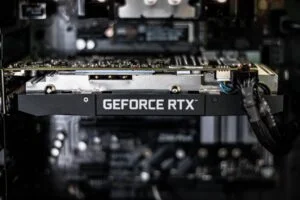Have you ever wondered about all the stuff you see on the screen when you play video games? It’s not just there for looks; it’s part of what makes the game work, and it’s called “UI” or “User Interface.” UI in gaming is like the game’s language that talks to you and helps you play. For example, let’s say a head-up display, this can also be an example of a user interface design and can give a positive user experience.
What Is UI In Gaming?
But what exactly is gaming UI, and why is it important in the gaming industry? In this detailed guide, we’ll break it down in easy-to-understand terms, exploring what UI means in gaming and how it impacts your gaming experience. By the time we’re done, you’ll have a deep understanding of the role UI plays in the gaming world.
Let’s start by making sure we’re on the same page about what UI means in the gaming context. UI stands for “User Interface.” It’s like the control centre of a game, where you do things like starting a new game, changing settings, saving your progress, or quitting the game, this helps with the user experience and the visual styles. Think of it as a game’s way of talking to you and helping you make choices.
Exploring UI Components in Gaming
Now, let’s take a closer look at the different parts that make up gaming UI and what they do:
1. Menus and Buttons
Menus are like the command centres of a game. They’re where you find options to start playing, save your game, change how the game looks or sounds, and even exit the game. Buttons are what you click or press to make things happen, like making your character jump, shoot, or interact with the game world.
2. Health and Status Bars
Have you ever noticed those bars at the corner of your screen that show how healthy or strong your character is? Those are health and status bars. They’re like thermometers for your character’s well-being. When the bars are low, it means your character is in trouble and needs to be careful.
3. Maps and Mini-Maps
Maps help you figure out where you are in the game world. Imagine you’re exploring a massive virtual world; a map helps you not get lost. Mini-maps show a smaller, simplified version of the game world on your screen so you can see where you are in real time.
4. Inventory and Items
In some games, you collect items like weapons, armour, or health-restoring potions. The inventory is like a magical backpack that holds all your items. It shows you what you’ve collected and lets you use them when you need them.
5. Dialog Boxes
Dialogue boxes are like windows that pop up on the screen when characters in the game talk to you. They show you what the characters are saying, and sometimes, they let you choose how to respond. This is how you can have conversations with the game’s characters.
Why Is Gaming UI Important?
Now that we know what gaming UI is, let’s talk about why it’s so crucial:
1. Helps You Play
UI makes the game easier to play. Imagine playing a game with no buttons to press or menus to navigate. It would be incredibly confusing and frustrating. UI is like your game’s guide, showing you how to interact with the game world.
2. Provides Important Information
UI gives you vital information about your game. It tells you how much health or energy your character has left, where you should go next, and what items you have. Without this information, you’d feel lost in the game world.
3. Immerses You in the Story
UI isn’t just about buttons and bars; it’s also about storytelling. A well-designed UI can make you feel like you’re part of the game’s story. It helps you connect with the characters and the game world around you.

Challenges in UI Design
Creating great gaming UI isn’t easy. Designers have a lot to think about:
1. Appearance and Layout
UI needs to look good and be easy to use. It has to fit the game’s style, whether it’s a colourful cartoon world or a dark and gritty one.
2. Compatibility
UI has to work on different devices, like game consoles, computers, and even smartphones. It’s a challenge to make it look and work well on all these different screens.
3. Balancing Information
UI game designers have to decide what information is important to show on the screen. Too much information can be overwhelming, while too little can leave you confused.
4. Player Experience
UI has to be designed with the player’s experience in mind. It should feel natural and not get in the way of enjoying the game.
Examples of UI in Popular Games
Let’s take a look at how UI is implemented in some well-known games:
Minecraft keeps its UI simple and clear, matching its blocky and creative style. Your inventory screen, health, and a hot bar with items you can use are neatly displayed, making it easy to craft, build, and explore.
The Legend of Zelda: Breath of the Wild
Breath of the Wild takes a minimalistic approach to UI. It doesn’t clutter your screen with information. Instead, it only shows you what’s essential at the moment, like your health, temperature, or time of day. This heads-up display design allows you to fully immerse yourself in the vast world of Hyrule.
Fortnite’s UI is designed for fast-paced action. It displays your weapons, building materials, and a map with markers, all neatly organized for quick access. It’s meant to keep you informed without slowing you down in the heat of battle and gives an enjoyable experience.
The Future of Gaming UI
As technology advances, gaming UI continues to evolve:
Virtual Reality (VR) and Augmented Reality (AR)
With the rise of VR and AR, UI is changing too. In VR games, UI might become part of the game world itself, allowing you to interact with it in a more immersive way. In AR, UI could blend seamlessly with your real surroundings through smart glasses, adding a layer of information and interactivity to your everyday life.
Conclusion
Gaming UI, or User Interface, is the essential link between you and the game. It encompasses everything from menus and buttons to health bars, maps, and dialogue boxes. UI is there to help you play, provide crucial information, and immerse you in the game’s story. It’s the result of careful design and balancing act by game developers to ensure it complements your gaming experience.
So, the next time you dive into a video game, take a moment to appreciate the UI that makes your gaming adventure possible. It’s not just a bunch of buttons and bars; it’s your gateway to new worlds, exciting challenges, and unforgettable stories. And as technology continues to push the boundaries of gaming, who knows what incredible UI experiences await us in the future?
Also Check Out:
Online Gaming Addiction: Is Your Mental Health At Stake?
Top 5 UPS to Buy for A Gaming PC in 2023








